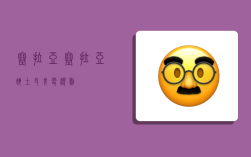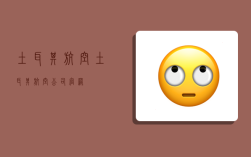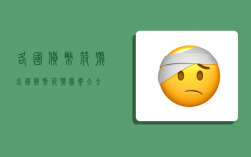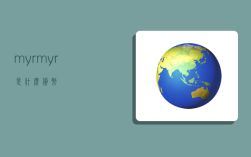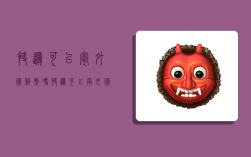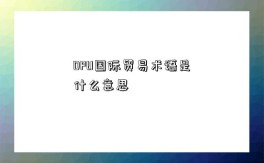TRL是什么货币,土耳其镑是亚洲国家土耳其的货币
TRL土耳其镑是哪个国家货币,TRL土耳其镑是什么货币?TRL是指土耳其镑,TRL是土耳其镑的英文简写,英文全称是Turkish-Pound (Turkish-Lira),TRL土耳其镑是亚洲国家土耳其的本土货币。土耳其镑(Turkish-Pound (Turkish-Lira))标准符号:TRL,货币原有旧符号:(£T. (TL.)),辅币进位制:1TRL=100 kurus(库鲁)。
耳其里拉(Turkish Lira/Turkish New Lira,又称土耳其镑Turkish Pound 原符号:£T. (TL.) 标准符号:TRL ISO 4217现行通用三位字母代码:TRY)土耳其里拉——跃居金氏纪录最不值钱货币。
土耳其里拉简介
土耳其里拉也称镑(Pound),由土耳其共和国中央银行 (The CentraI Bank of the Republicof Turkey)发行。
土耳其史称突厥。14世纪初建立奥斯曼帝国,20世纪沦为英、法、德等国的半殖民地,1923年10月29日成立土耳其共和国。1840年土耳其帝国第一次发行了500库鲁手绘利息为12.5%的票据,同年第二次发行的面额有1000、500、250、100和50库鲁。第三次发行是1841年和 1843年。第四次是1851年发行的、利息为6%的票据,面额有10000、5000、2000、1000、250、100和50库鲁。从1840年到1861年共发行过8次。土耳其帝国银行依据1862年2月6日、1912年3月30日、1912年12月16日、1912年12月22日、1913年3 月2比1913年8月6比1913年2月4日、1914年3月28日和1915年3月28日等法令发行过钞票。如1933年,曾发行过面额为100、 50、5和1镑钞票。土耳其共和国成立后,于1926年发行过面额为1000、500、100、50、10、5和1里拉钞票。土耳其中央银行(Tukiye CumhriyetMer Bankasi)发行第一版钞是依据1930年1月30日中央银行法,于1937年至1942年发行的。面额有1000、500、100、50、10、5、2.5和1里拉和50库鲁钞票。第二版钞是1942年至1947年发行的,面额有1000、500、 100、50、10、2.5里拉;第三次发行是1947年和1948年,面值为100和10里拉;第四次是1952年至1968年,第五次发行是在 1966年和1968年;第六次发钞是1971年至1981年,面额有5000、1000、500、100、20、10和5里拉;第七次发行是1984年至1989年,面额有50000、20000、10000、5000、1000、500、100、10里拉。1991年发行了100000里拉钞票。
1947年6月3日,初次规定土耳其里拉含金量为0.317382克,同年6月19日起生效。法定汇率为 2.80里拉等于1美元,11.28里拉等于1英镑。1960年8月20日,里拉含金量减至0.0987412克,法定汇率为9里拉等于1美元, 25.20里拉等于1英镑。1970年8月9日,里拉含金量减至0.0592447克,法定汇率随之变动。1972年6月23日,英镑浮动后,土耳其里拉兑英镑汇率随时调整。1975年7月8日起,对美元贬为14.25里拉等于1美元,并实行自由浮动,但仍以美元作为干预货币,对其他主要货币,随时根据美元汇率进行调整。1986年10月31日,官方规定里拉的买卖差价为0.5%。里拉兑美元的汇率由土耳其共和国中央银行根据每日外汇市场行情确定,兑其它货币的比价则由外汇市场美元兑其它货币汇率套算确定。
2001年初土耳其央行曾计划发行新的纸币,新币的面额1土耳其里拉相当于原来的100万土耳其里拉。央行总裁森丹杰契提却表示,惟有在通货膨胀率降至一位数以下时,央行才会考虑这样做。但2001年9月以来,土耳其通货膨胀率已超过70%,因此上述想法只能作罢。
2001年11月11日土耳其中央银行宣布,市场上面额1000万的土耳其里拉钞票流通率已超过80%,央行决定在11月底之前发行面额2000万土耳其里拉的钞票,它成为全球面额最大的钞票。以汇率1美元兑160万土耳其里拉计算,2000万土耳其里拉,约合12.5美元。领取最低工资的土耳其工人,每月可领到7张2000万土耳其里拉的纸币。
据2001年金氏纪录大全记载,土耳其里拉是全世界“最不值钱的货币”,以2000年5月份世界各国的币值比较,1美元等于61万5千土耳其里拉,台币1元约等于2万土耳其里拉。
2004年10月25日土耳其中央银行首次向公众公开了于2004年12月正式发行的新货币——“新土耳其里拉”纸币。
新货币包括“1新土耳其里拉”、“2新土耳其里拉”、“5新土耳其里拉”、“10新土耳其里拉”、“20新土耳其里拉”、“50新土耳其里 拉”和“100新土耳其里拉”纸币。新币正面均印有土耳其国父穆斯塔法·凯末尔·阿塔图尔克的肖像,背面画像各不相同,颜色也不一样。土耳其还将发行1、2、5、10、25、50小货币单位的“库鲁什”硬币。
土耳其大国民议会2004年早些时候通过了一项法案,同意财政部于2005年1月1日起开始流通“新土耳其里拉”,以取代现在的“土耳其里拉”。“1新土耳其里拉”等于现在的“100万土耳其里拉”。 而面值100的新“库鲁什”硬币相当于“1新土耳其里拉”。
根据有关规定,“新土耳其里拉”于2005年1月1日开始使用。新旧土耳其里拉过渡到2005年12月31日为止。随后,旧土耳其里拉停止使用。
土耳其里拉币值与换算
纸币有:100000、50000、20000、10000、500、1000里拉
新货币包括:1、2、5、10、20、50和“100新土耳其里拉”
铸币有:100、50、25、 20、10、5、1里拉和1、 2、5、10、25、50小货币单位的“库鲁什”
1里拉等于100库鲁(Kurus)。
1土耳其里拉 = 5.73048622 × 10-6 人民币
英文介绍:
Old Turkish Lira
Up until 2005 the Turkish currency was the Turkish lira or in Turkish; Türk lirası, it was often referred to as just lira but almost always referred to as the Turkish lira outside Turkey, to avoid confusion with the better-known former Italian lira. Prices in Turkey is old lira were usually written using the abbreviation TL, which preceded the price, The ISO 4217 code for the old Turkish lira was TRL.
The gold lira was introduced in 1843, weighing 7.216 g with a fineness of 91.67%, that is, 6.6 g of gold. In a bimetallic system, it was defined as equal in value to 100 silver kuruş of 1 g of silver (1.2027 g at 83%), first minted in 1844, at a ratio of 15.09. Each kuruş was divided into 40 para. There were 5, 10, and 20 kuruş coins; the 20-kuruş coin was called a mecidiye. All coinage minted until 1922 followed these standards.
Before the lira, the monetary unit used by the Ottoman Empire was first the akçe, later to be replaced by the kuruş (piastre), with the para as a subunit (1 para being equal to 3 akçe, thus 1 kuruş equal to 120 akçe). Having begun as a large silver coin, by the late 1800s the kurus had shrunk to a small silver coin.
The Banque Imperiale Ottomane (Imperial Ottoman Bank) first issued paper currency denominated in kuruş, with values ranging from 5 to 5000 kurus. The denomination switched from kuruş to lira in the mid 1870s. Denominations ranged from 5 kuruş to 1000 lira, with the 50,000-lira banknote specially prepared to fund the issue of small change (1- and 2½-kurus) notes.
World War I saw Turkey effectively depart from the gold standard with the gold lira being worth about nine lira in paper money by the early 1920s.
The Turkish Republic replaced the older imperial Ottoman paper liras with the Turkish lira being reissued as a mid size silver coin. Turkish lira notes were also introduced in denominations of 1, 2½, 5, 10, 50, 100, 500 and 1000 lira. Each note carried the portrait of Mustafa Kemal Atatürk.
After Atatürk's death in 1938, new notes were prepared with the portrait of President İsmet İnönü. Atatürk reappeared on a subsequent series of notes in the early 1950s.
Chronic inflation from the late 1970s onward saw the Turkish lira sharply depreciate against other major currencies. The table below gives a snapshot of the decline in the value of the Turkish lira against the United States Dollar from 1933 through 2001.
YEAR Turkish Lira vs. US Dollar
1933 2 Turkish Lira
1966 9 Turkish Lira
1980 90 Turkish Lira
1988 1,300 Turkish Lira
1995 45,000 Turkish Lira
2001 1,650,000 Turkish Lira
The Turkish lira slid in value to such an extent that one original gold lira coin could be sold for approximately 120,000,000 Turkish lira prior to the 2005 revaluation.
In its last few years the Turkish lira stabilized and even rose against the U.S. dollar and the Euro. In December 2004, it traded at about 1,350,000 lira to 1 U.S. dollar, and about 1,850,000 lira per Euro. The Guinness Book of Records ranked the Turkish lira as the world's least valuable currency.
New Turkish Lira "Yeni Türk Lirası"
The new Turkish lira is the current currency of Turkey and of the de facto state of the Turkish Republic of Northern Cyprus. Introduced on 1 January 2005, it is equivalent to 1,000,000 old Turkish lira. New banknotes were issued denominated in New Turkish Lira, the old banknotes circulated alongside the new currency for all of 2005. Old Turkish lira banknotes were legal tender until the end of 2005, and may be exchanged at the Central Bank until the end of 2015. The new Turkish lira is divided into 100 new kuruş. The ISO 4217 code for the new Turkish lira is TRY. Prices are expressed using the abbreviation YTL, which short for "Yeni Türk Lirası", Turkish for "New Turkish Lira"
Banknotes are currently issued in denominations of 1 YTL, 5 YTL, 10 YTL, 20 YTL, 50 YTL and 100 YTL. The Bank of Turkey has indicated that it has plans to issue a new 200 YTL banknote, although the new denomination is not expected for a couple of years. It is also planned to drop the word "New" from the currency name in 2009.
Coins currently in circulation come in denominations of 1, 5, 10, 25, 50 new kuruş, and 1 YTL. The design of the 50 kuruş and 1 lira coins, much to the dismay of the European Central Bank, clearly resembles that of the one and two euro coins respectively. This has caused confusion in the euro zone. Also, it has caused trouble to businesses using vending machines, particularly at airports in the euro zone. Since numerous vending machines at the time accepted the 1 lira coin as a two euro coin, vending machines affected had to be quickly upgraded at the expense of the operators. Two euros is worth roughly four times more then a 1 lira coin.
中文翻译:
旧土耳其里拉。直到2005年,土耳其的货币是土耳其里拉或土耳其语;Türk Lirası,通常被称为里拉,但在土耳其以外几乎总是被称为土耳其里拉,以避免与更知名的前意大利里拉混淆。在土耳其,旧里拉的价格通常是用缩写TL写的,在价格之前,ISO 4217代码是旧土耳其里拉的TRL。
金里拉于1843年问世,重7.216克,纯度为91.67%,即6.6g黄金。在双金属系统中,它的价值被定义为等于100银库鲁ş1克银(83%,1.2027克),于1844年首次铸造,比率为15.09%。每个库鲁ş被分成40段。有5个、10个和20个库鲁ş硬币;20个库鲁ş硬币被称为Mecidiye。
1922年以前铸造的所有硬币都遵循这些标准。在里拉之前,奥斯曼帝国使用的货币单位首先是阿克塞,后来被库鲁ş(皮阿斯特尔)所取代,并将帕拉作为一个子单位(1段等于3阿克索,因此1库鲁ş等于120阿克索)。库鲁斯最初是一枚大银币,到19世纪末已缩水为一枚小银币。
奥斯曼帝国银行(Imperial Ottoman Bank)首次发行了以库鲁ş计价的纸币,面值从5到5,000韩元不等。19世纪70年代中期,教派从库鲁ş改为里拉。面额从5库鲁ş到1,000里拉不等,其中50,000里拉纸币是专门为发行零钱(1和2.5库拉)而准备的。
第一次世界大战期间,土耳其实际上脱离了金本位制,到20世纪20年代初,金里拉的纸币价值约为9里拉。土耳其共和国用土耳其里拉取代了旧的奥斯曼帝国纸里拉,重新发行了中等大小的银币。土耳其里拉纸币也推出了1、2/5、5、10、50、100、500和1000里拉的面额。
每张钞票上都印有穆斯塔法·凯末尔·阿塔图尔克的肖像。1938年阿塔图尔克去世后,新的钞票上印有İSmetİNönü总统的肖像。20世纪50年代初,阿塔图尔克再次出现在随后的一系列音符上。自20世纪70年代末以来的长期通胀导致土耳其里拉对其他主要货币大幅贬值。下表显示了1933年至2001年期间土耳其里拉对美元汇率的下降情况。
年土耳其里拉兑美元。
1933年2土耳其里拉。
1966年9月土耳其里拉。
1980 90土耳其里拉。
1988年1300土耳其里拉。
1995年45,000土耳其里拉。
2001年1,650,000土耳其里拉。
土耳其里拉贬值到了这样的程度,在2005年升值之前,一枚原始的金里拉硬币可以卖到大约1.2亿土耳其里拉。
在过去的几年里,土耳其里拉稳定下来,甚至对美元和欧元升值。
2004年12月,里拉兑美元汇率约为1,350,000里拉兑1美元,欧元兑里拉约为1,850,000里拉。
吉尼斯世界纪录将土耳其里拉列为世界上最不值钱的货币。
土耳其新里拉“Yeni Türk Lirası”
新的土耳其里拉是土耳其的现行货币,也是北塞浦路斯土耳其共和国事实上的国家的货币。
2005年1月1日推出,相当于100万年前的土耳其里拉。
发行了以新土耳其里拉为面值的新钞票,2005年全年旧钞票与新货币一起流通。
旧的土耳其里拉钞票在2005年底之前一直是法定货币,在2015年底之前可以在中央银行兑换。
新的土耳其里拉被分成100个新的库鲁ş。
新土耳其里拉的ISO 4217代码是Try。
价格用缩写ytl表示,ytl是“Yeni Türk Lirası”的缩写,土耳其语是“新土耳其里拉”的缩写。
目前纸币的面额分别为1YTL、5YTL、10YTL、20YTL、50YTL和100YTL。
土耳其银行表示,它计划发行新的200 YTL纸币,尽管新面额预计在几年内不会发行。
它还计划在2009年将“新”一词从货币名称中删除。
目前流通的硬币有1、5、10、25、50新库鲁ş和1 YTL的面额。
令欧洲央行大为失望的是,50库鲁ş和1里拉硬币的设计显然分别与1欧元和2欧元硬币相似。
这在欧元区引发了混乱。
此外,它还给使用自动售货机的企业带来了麻烦,特别是在欧元区的机场。
由于当时许多自动售货机接受1里拉硬币作为2欧元硬币,受影响的自动售货机不得不迅速升级,代价是运营商。
两欧元的价值大约是一枚1里拉硬币的四倍。
土耳其里拉样币
Banknotes denominated in New Turkish Lira (2005 - Present)The new Turkish lira is the current currency of Turkey and of the de facto state of the Turkish Republic of Northern Cyprus. Introduced on 1 January 2005, it is equivalent to 1,000,000 old Turkish lira, which remained legal tender until the end of 2005, the new Turkish lira is divided into 100 new kuruş.
土耳其里拉铸币
TRL是什么货币,土耳其镑是亚洲国家土耳其的货币
TRL是什么货币,土耳其镑是亚洲国家土耳其的货币发表于2023-02-11,由周林编辑,文章《TRL是什么货币,土耳其镑是亚洲国家土耳其的货币》由admin于2023年02月11日发布于本网,共9910个字,共6961人围观,目录为货币百科,如果您还要了解相关内容敬请点击下方标签,便可快捷查找与文章《TRL是什么货币,土耳其镑是亚洲国家土耳其的货币》相关的内容。
版权声明:
文章:(TRL是什么货币,土耳其镑是亚洲国家土耳其的货币),来源:土耳其,阅读原文。
TRL是什么货币,土耳其镑是亚洲国家土耳其的货币若有[原创]标注,均为本站原创文章,任何内容仅供学习参考,未经允许不得转载,任何内容不得引用,文章若为转载文章,请注明作者来源,本站仅为分享知识,不参与商业活动,若有侵权请联系管理删除

























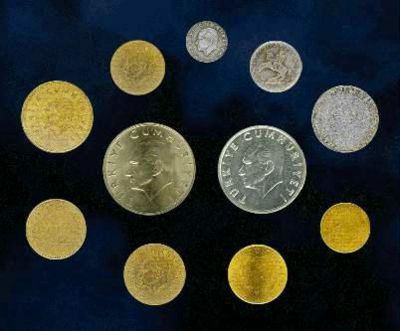
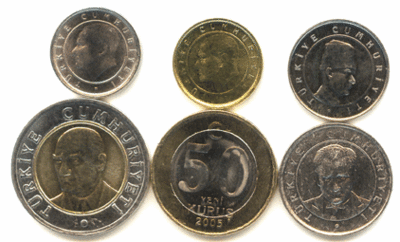

 微信扫一扫打赏
微信扫一扫打赏
 支付宝扫一扫打赏
支付宝扫一扫打赏

